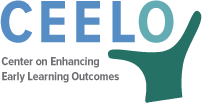 Developing a Theory of Change
Developing a Theory of Change
Heeding Steven Covey’s words to “Begin with the end in mind,” effective leaders and organizations have a clear purpose which guides all systemic planning and action. Lacking a vision or purpose, many resources may be spent on activities that serve no purpose and yield few results. Effective systems rely on a logic model or theory of change to achieve the desired results. Data provides insight for early education leaders to measure the results of their performance and progress toward these ends.
Early education is about young children. From a leader and program administrator perspective, however, it is all about the results that are achieved. The intended result of the early education system is to enhance the development and learning of young children; results typically expressed in terms of measurable outcomes such as developmental gains, school readiness, or reading proficiency. Other important results may include program quality, teacher qualifications and effectiveness, access, resources, and other related measures. Effective early education leaders understand Results-based Accountability (RBA) and are skillful in Results-based Facilitation (RBF).
 What are Results-based Accountability and Leadership?
What are Results-based Accountability and Leadership?
RBA and RBF are the two foundational skills for Results-based Leadership. Developed by former state administrator Mark Friedman, RBA (also known as Outcomes-Based Accountability) is a disciplined way of thinking and taking action that focuses on improving the lives of children and families as a whole. State and local organizations use RBA’s data-driven, decision-making process to improve the performance of their programs and services to improve results.
In Trying Hard is Not Good Enough: How to Produce Measurable Improvements for Customers and Communities (Friedman, 1995) explains that as organizations and programs strive for impact, they can only be held accountable for the population they serve. RBA helps agencies clarify the role they play in state- and community-level impact by targeting the specific population intended to benefit from the services the agency provides and how effectively the agency is improving results for that population. RBA asks several questions to measure data on effort and effect to address both impact on the population and program performance accountability.
Early education leaders familiar with the principles and skilled in applying tools of RBA can use results-based facilitation (RBF) as an ongoing process involving multiple stakeholders to effectively engage, plan, implement, and evaluate both the impact and effectiveness of their programs. RBF also holds participants accountable for advancing the work.
 Data is at the center of RBA and RBL
Data is at the center of RBA and RBL
Data provides concrete measurement which can be analyzed and transformed into actionable knowledge. Effective early education leaders can understand data and its validity, identify reliable data sources, and analyze and interpret data.
Data may exist on a national, state, and program levels. The NIEER State of Preschool yearbook provides a comprehensive compilation of all preschool programs administered by state agencies. Valuable data on Head Start are also available for leaders through the Department of Health and Human Services’ Program Information Report. The United States Census Bureau also maintains multiple databases of value to education leaders. States also identify data needs and collect information which is often reported on state and local levels. High-quality programs collect data as part of a continuous improvement cycle.
Data comparisons can produce graphic depictions of trends. Behavior Over Time Graphs (BOTG) are used in systems thinking to plot data as a way to measure improvements or setbacks of desired results (i.e., school readiness, pre-K suspension, promotion rates). BOTG also are used in concert with other tools and processes to explore the “story behind” the numbers. Early education leaders employ data to underscore purpose and commitment and facilitate action for continuous improvement.
Resources
- Logic Models and Outcomes for Early Childhood Programs (Child Trends)
- Learning From Logic Models: An Example of a Family/School Partnership Program (Coffman, 1999)
- What is Theory of Change? (Center for Theory of Change)
- 5-2-2 of Results-Based Leadership (Annie E. Casey Foundation)
- Trying Hard is Not Good Enough: How to Produce Measureable Improvements for Customers and Communities (Friedman, 2005)
- Results-Based Accountability (webpage, slides, video)
- RBA Implementation Guide
- Results-Based Facilitation (Introduction, Foundation Skills, Advanced Skills)
- Results-Based Facilitation: Moving from Talk to Action (Pillsbury, 2013)
- Common Facilitation Challenges
- NIEER Annual State of Preschool Yearbook (NIEER)
- Behavior Over Time Graphs (BOTG) Tips (Waters Foundation)
- An Unofficial Guide to the Why and How of State Early Childhood Data Systems (Regenstein/OUNCE, 2017)
- Guide to Results-Based Planning and Facilitation: Achieving Results and Equity for Vulnerable Children and Youth (National Results and Equity Collaborative, 2014)
Activities
- Logic models for program design, implementation, and evaluation: Workshop toolkit (EDC)
- Logic Model Development flow chart
- Seven Questions of Accountability
- Behavior Over Time Graphs and Connection Circle Practice (pp. 4 & 5)
- Facilitation Skills Self-Assessment (Thinking Collaborative, 2017)
